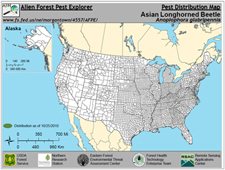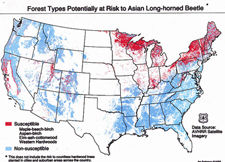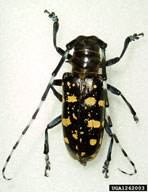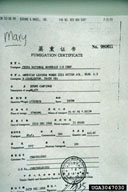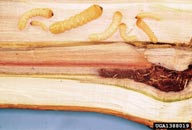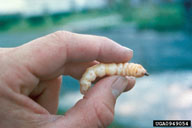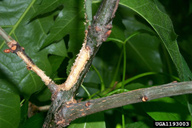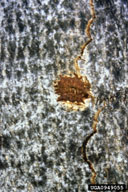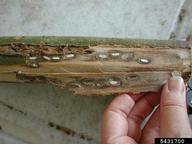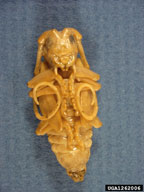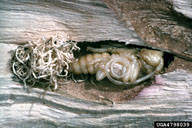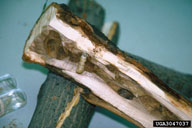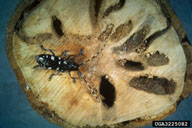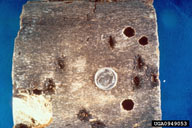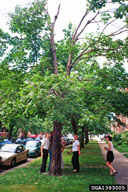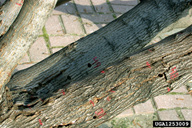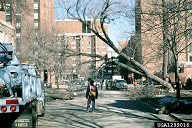Asian longhorned beetle
Anoplophora glabripennis Motschulsky, (Coleoptera: Cerambycidae)
Orientation to pest
Asian longhorned beetle, Anoplophora glabripennis, Motschulsky, is native to Asia (principally China) and invasive in parts of western Europe, and in several American cities, where eradication efforts are underway. This borer attacks a variety of hardwood trees. In China, Asian longhorned beetles are not damaging in forests, but because of extensive planting of certain poplars (exotic varieties) that proved highly susceptible to the species, the insect increased in abundance. This action facilitated the beetle's dissemination to other countries because infested wood was used for packing material. The biology of the species is typical of many longhorn beetles. Adults emerge over an extended period from spring to fall, but especially in late June to early July. Adults remain on or near their emergence tree and engage in maturation feeding on leaves, petioles, and tender bark. Eggs are laid singly under the bark, in egg sites chewed by females. Larvae feed in the cambium layer of the tree and later into the heartwood. Larvae dig pupation chambers inside the tree, which can be filled with frass. Adults emerge via large (1 cm dia) round exit holes, which are a visible sign of infestation. In southern Asia, a generation requires one year, but in northern areas, two years are required. Generations may be overlapping. Unlike many cerambycids, A. glabripennis attacks healthy trees as well as those under stress. Several generations can develop within an individual tree, eventually killing it.
Hosts commonly attacked
In China (the native range), the major hosts of A. glabripennis are certain species of Populus, especially Populus nigra L., Populus deltoides W. Bartram ex Marshall, Populus x canadensis and the Chinese hybrid Populus dakhuanensis. Other important hosts are the willows Salix babylonica L. and Salix matsudana Koidzumi. Other species also recorded as hosts in China include species of Acer, Alnus, Malus, Morus, Platanus, Prunus, Pyrus, Robinia, Rosa, Sophora, and Ulmus. In urban areas in North America invaded by this species, the hosts attacked by this beetle have been species of maple (Acer negundo L., Acer platanoides L., Acer pseudoplatanus L., Acer rubrum L., Acer saccharinum L., and Acer saccharum Marshall) and Aesculus hippocastanum L. However, it has also been found on a range of other hardwoods, including Liriodendron tulipifera L., Morus alba L., Robinia pseudacacia L., and species of Betula, Fraxinus, Populus, Salix, and Ulmus.
Distribution
Asian longhorned beetle is native to Asia. It has been detected in parts of Europe and in North America (Toronto, Canada, Illinois, the greater New York City area, New Jersey, and Massachusetts).
| Figure 1. Current infestations (green areas) of Asian longhorned beetle in the United States | Figure 2. Potential areas at risk of becoming infested (red areas) |
Images of Asian longhorned beetle
| Figure 2. Adult of Asian longhorned beetle, Anoplophora glabripennis | Figure 3. The invasion of North America by Asian longhorned beetle was likely caused by the shipment of massive quantities of raw wooden packing material from Asia (left). To reduce risks of further such invasions, wooden packing material must now be fumigated (right) or heat treated to kill larvae or other stages in wood. | ||
| Figure 4. Chewed bark on twig, caused by maturation feeding of adult Asian longhorned beetles | Figure 5. Left, sign on the trunk of oviposition (chewed pit); right, eggs of Asian longhorned beetle | Figure 6. Mixed age (top) and mature (bottom) larvae of Asian longhorned beetle | |
| Figure 7. Pupa of Asian longhorned borer; left, extracted; right, in a pupal chamber, with frass | Figure 8. Larva feeding tunnels of Asian longhorned beetles in small trunk (left) and tunnels as seen in cross section of cut branch (right) | ||
| Figure 9. Emergence holes of Asian longhorned beetles | Figure 10. Dead branches in tops of trees are sign of Asian longhorned beetle infestation. | Figure 11. Survey for Asian longhorned beetle infestations are based on visual detection of all signs of infestation; eradication efforts includes implementing a regulated area (quarantine), conducting surveys of host trees, removing of infested trees and using treatment applications. | |
Important biological control agents related to this pest species
Compared with other longhorned beetles, relatively few natural enemies of ALB have thus far been identified. Egg parasitoids are unknown. Larval parasitoids include Dastarcus longulus Sharp (Coleoptera: Colydiidae), Scleroderma guani Xiao et Wu (Hymenoptera: Bethylidae), Bullaea sp (Diptera: Tachinidae), and Megarhyssa sp. (Hymenoptera: Ichneumonidae). Pupal parasitoids include D. longulus, S. guani, and Aprostocetus sp. (Hymenoptera: Eulophidae). Among these, D. longulus and S. guani, appeared to be the most promising for biological control purposes (see websites mentioned below for further details).
Web links for information on Asian longhorned beetle
- Fact Sheet | Introduced Pests Outreach Project, Massachusetts Cooperative Extension
Provides information on on biology and recognition - Fact Sheet | UMass Extension
From the Massachusetts Landscape, Nursery, and Urban Forestry Program - Quarantined Pest Data Sheet | European & Mediterranean Plant Protection Organization
- Wikipedia Article | Wikipedia, the free encyclopedia
- Biocontrol Research | University of Vermont
Discussion of natural enemies of Asian longhorn borer found in surveys in China - Beetle Busters Website | USDA APHIS
USDA Asian longhorned beetle website
Articles
- Cavey, J. F., E. R. Hoebeke, S. Passoa, and S. W.Lingafelter. 1998. A new exotic threat to North American hardwood forests: an Asian longhorned beetle, Anoplophora glabripennis Motschulsky) Coleoptera: Cerambycidae: I. Larval description and diagnosis. Proceedings of the Entomological Society of Washington 100(2): 373-381.
- Haack, R.A., K. R. Law, V. C. Mastro, H. S. Ossenbruggen, and B.J. Raimo. 1997. New York's battle with the Asian long-horned beetle. Journal of Forestry 95(12): 11-15.
- Li, W. and C. Wu. 1993. Integrated Management of Longhorn beetles Damaging Poplar Trees. Beijing, China. Forest Press. 290 pp.
- Nowak, D. J., J. E. Pasek, R. O. Sequeira, D. E. Crane, and V. C. Mastro. 2001. Potential effect of Anoplophora glabripennis (Coleoptera: Cerambycidae) on urban trees in the United States Journal of Economic Entomology 94(1): 116-122.
- Hu, J. F., S. Angeli, S. Schuetz, Y. Q. Luo, and A. E. Hajek. 2009. Ecology and management of exotic and endemic Asian longhorned beetle Anoplophora glabripennis. Agricultural and Forest Entomology 11: 359-375.
